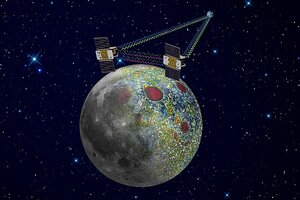NASA Grail probes circling the moon on New Year's Day
After a 3½-month journey, a NASA spacecraft flew over the moon's south pole, fired its engine and dropped into orbit in the first of two back-to-back arrivals over the New Year's weekend.

This artist rendering provided by NASA shows the twin Grail spacecraft mapping the lunar gravity field. The two probes began orbiting the moon over New Year's weekend.
Jet Propulsion Laboratory/NASA/AP
Pasadena, California
As planet Earth rang in the New Year, a different kind of countdown was happening at the moon.
After a 3½-month journey, a NASA spacecraft flew over the moon's south pole, fired its engine and dropped into orbit Saturday in the first of two back-to-back arrivals over the New Year's weekend.
Mission control at the NASA Jet Propulsion Laboratory erupted in cheers and applause after receiving confirmation that the probe was healthy and circling the moon. An engineer was seen on closed-circuit television blowing a noisemaker to herald the New Year's Eve arrival.
"Everything went just as we hoped. The burn was spot-on," chief scientist Maria Zuber of the Massachusetts Institute of Technology said in a post-mission interview with The Associated Press.
The team toasted sparkling cider, but the celebration was brief. Despite the successful maneuver, the work was not over. Its twin still had to enter lunar orbit on New Year's Day.
Cool Astronomy: Is the moon really a 'been there done that' world?
The Grail probes – short for Gravity Recovery and Interior Laboratory – have been cruising independently toward their destination since launching in September aboard the same rocket on a mission to measure lunar gravity.
Hours before revelers in Times Square celebrated the New Year, Grail-A approached the moon and fired its engine for about 40 minutes to get captured into orbit. Deep space antennas in the California desert and Madrid tracked every move and fed real-time updates to ground controllers
About 270 family members and friends of the mission team descended on the NASA campus to watch the drama unfold on a live feed.
"This is great, a big relief," deputy project scientist Sami Asmar told the jubilant crowd.
Grail is the 110th mission to target the moon since the dawn of the Space Age including the six Apollo moon landings that put 12 astronauts on the surface. Despite the attention the moon has received, scientists don't know everything about Earth's nearest neighbor.
Why the moon is ever so slightly lopsided with the far side more mountainous than the side that always faces Earth remains a mystery. A theory put forth earlier this year suggested that Earth once had two moons that collided early in the solar system's history, producing the hummocky region.
Grail is expected to help researchers better understand why the moon is asymmetrical and how it formed by mapping the uneven lunar gravity field that will indicate what's below the surface.
Previous lunar missions have attempted to study the moon's gravity – which is about one-sixth Earth's pull – with mixed results. Grail is the first mission devoted to this goal.
Once in orbit, the near-identical spacecraft will spend the next two months refining their positions until they are just 34 miles above the surface and flying in formation. Data collection will begin in March.
The $496 million mission will be closely watched by schoolchildren. An effort by Sally Ride, the first American woman in space, will allow middle school students to use cameras aboard the probes to zoom in and pick out their favorite lunar spots to photograph.
Despite the latest focus on the moon, NASA won't be sending astronauts back anytime soon. The Obama administration last year nixed a lunar return in favor of landing humans on an asteroid and eventually Mars.
A jaunt to the moon is usually speedy. It took the Apollo astronauts three days to zip there aboard the powerful Saturn V rocket. Since NASA wanted to economize by launching on a small rocket, it took Grail a leisurely 3 1/2 months to make a roundabout trip.
NASA's last moonshot occurred in 2009 with the launch of a pair of spacecraft – one that circled the moon and another that deliberately crashed into the surface and uncovered frozen water in one of the permanently shadowed lunar craters.
Cool Astronomy: Is the moon really a 'been there done that' world?

